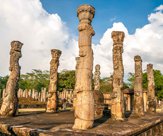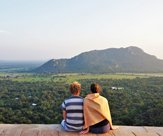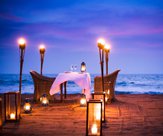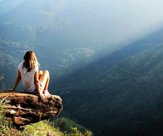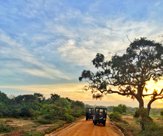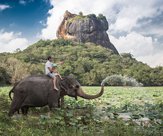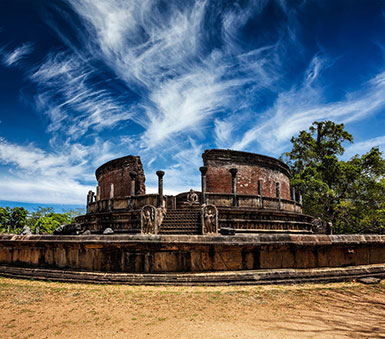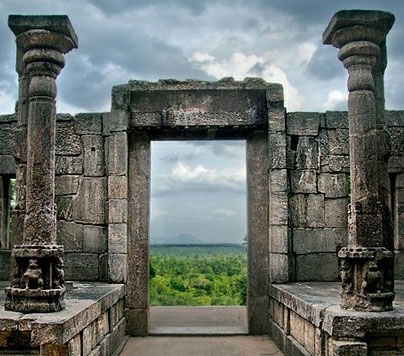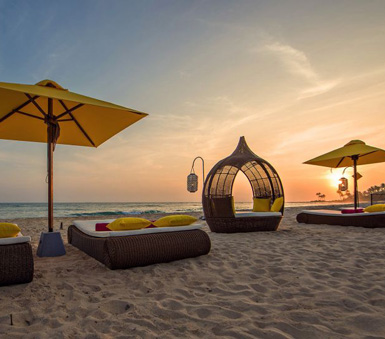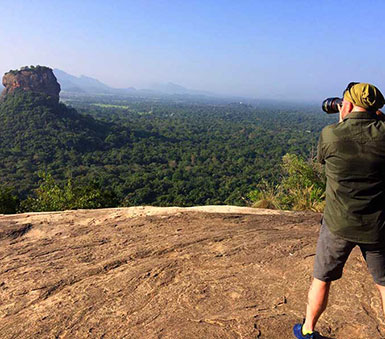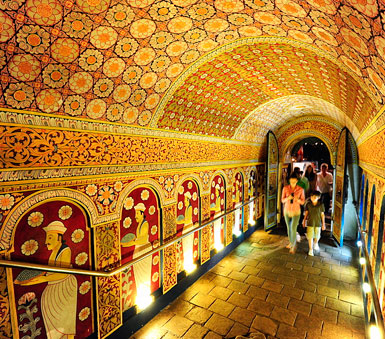Polonnaruwa Sri Lanka
Polonnaruwa (Sinhalese – පොළොන්නරුව Tamil – பொலநறுவை was the country’s capital from the 11th– 13th Century. Polonnaruwa Sri Lanka is considered one of the best preserved historic cities in the world. Located approximately 140km from Kandy, Polonnaruwa was declared a UNESCO World Heritage Site, due to its abundance of historic remains.
Most commonly referred to as Sri Lanka’s second ancient capital, the city of Polonnaruwa is nevertheless a magnificently preserved city with rich archaeological monuments and natural beauty. Located in Sri Lanka’s North Central Province, Polonnaruwa has both its ancient city, an adjoining “old town” as well as a “new town” located about 6km away. The archaeological sites are in a compact layout, within easy distance of each other, and tours are easily arranged either on foot or more popularly explored on bicycle.
As in Anuradhapura, Polonnaruwa too has its share of Buddhist sites, and tour buses of pilgrims can be often seen visiting the stupas and monasteries. But Polonnaruwa also boasts an impressive array of ruined palaces and courtyards, pleasure gardens and intricate networks of bathing tanks, as well as carvings and sculptures and a rich display of artistry. The ancient city was declared a World heritage Site by UNESCO in 1982.
Parakrama Samudra
One of the most striking features in Polonnaruwa is the vast Parakrama Samudra (Sea of Parakramabahu), an irrigation tank built, as the name indicates by King Parakramabahu the Great. This was his largest irrigation project and covers an area of more than 15 Km2.The dam (or bund, as it is known in Sri Lanka, is almost 14 Km long and 12 metres high.
The waters of the Parakrama Samudraya circle the ancient city and its environs, and in ancient times served as a moat against invading armies. An intricate network of irrigation canals supplied water from this reservoir to surrounding paddy fields, ensuring that agricultural production could be carried out year-round. The hitherto rain-fed agricultural practices were transformed, and Polonnaruwa became the rice growing capital of ancient Lanka.
The Dipuyyana (Island Garden) is on the promontory by the rest house. When King Parakramabahu had built his vast lake, he selected this lovely spot for a royal garden. Later King Nissankamalla liked it so much that he built his palace and council chambers there.
Royal Palace and Council Chambers
Among the most noteworthy buildings in ancient Polonnaruwa was the Royal Palace of King Parakramabahu I. The Palace must have been an imposing edifice, and the chronicles describe it as “seven stories high, furnished with a thousand chambers”. Entering the palace from the south, you come to great hall (31 Metres long and 13 metres wide), which was probably an audience hall. Although the Palace itself is in ruins, the frieze of elephants in the main Audience Hall and the many carvings and moonstones along the entry ways to the palace buildings are worth exploring.
Across the way is the council chamber of Parakramabahu – embellished with lion portals, graceful pillars and a moonstone (a delicately carved stepping stone). The building is supported by powerful bas-relief elephants around the base. Each one is different from the next.
Siva Shrine – Siva Devale No:1.
A Hindu Temple of chaste and restrained line dedicated to God Siva. This temple dates to the later Polonnaruwa period, and was probably built during a period of Indian domination in the thirteenth century. A number of superb bronzes in mature Choler style were found at this temple, and these can be seen at the Colombo Museum.
The Thuparama in Polonnaruwa
This oblong brick image house occupies the southwest corner of the adjoining quadrangle. The Thuparama, is a large Buddhist image house.
Inside the building, in the inner sanctum, is a ruined brick and plaster pile, that was once a seated image of the Buddha. The original vaulted roof of the building is still intact. Tropical rains run down the curve of the roof, and like the gargoyles of medieval Europe, Makara (dragon) spouts drain the water to the ground.
The Vatadage
This circular relic house possesses an elegance and beauty that is rare even in ancient Sri Lanka. In line with the outer circle of stone pillars is a tastefully ornamented screen wall patterned with four petaled flowers.
The flights of access stairs at the cardinal points are of stone and are beautifully carved. At the head of each flight is a Buddha statue in stone. The shrine is lavished with moonstones., guard stones and sculptured writings.
The shrine, like all dagobas in Sri Lanka, is oriented towards the cardinal points – north, south, east and west. Four Buddha statues face outwards, with their backs to the dagaba mound.
Nissanka Lata Mandapaya
A very pretty pavilion, this floral altar in stone has pillars which simulate with rare grace, a lotus on a stalk. This is a sacred hall of unknown purpose, and it was built by Nissankamalla. In the centre of the building is a small model dagaba, with worshippers sculptured around the base.
The Satmahal Prasada
A square pyramidal tower in seven tiers – a Dagaba of novel design. Each side of each tier is ornamented by a figure of a deity in an arched niche. The simple, stepped design is a very ancient form of architecture which occurs in the step pyramids of Egypt, and the ziggurats of Mesopotamia. Another building of this type occurs in Thailand in the monastery of Vat Kukut at Lamphun, and both are probably derived from an earlier Indian prototype.
Hatadage
The Shrine of Sixty Relics, which stands opposite the Vatadage. It was claimed to have been built by King Nissankamalla to house the Sacred Tooth Relic and is a handsome edifice, whose plain ashlar walls are very artistically relieved by a double border of faintly incised carving. However despite Nissankamalla’s claim, it may in fact been built by Parakramabahu.
Gal Potha (Stone Book)
A massive 8 metre long and 4.3 metre wide stone slab, which lies by the side of the Hatadage is inscribed with the deeds of King Nissankamalla. The massive inscription, amongst other things, records Nissankamalla’s brief invasion of India in glowing terms, and details of his relations with foreign states, as far away as modern Pakistan and Indonesia.
Pabulu Vehera in Polonnaruwa
To the east is the softly rounded dagoba. the Pabulu Vehera or Coral Shrine. It is said to have built by Rupavati, one of the queens of Parakramabahu. There are a number of Buddha images to dating from the later Polonnaruwa period to be seen around the dagoba.
Ran Kot Vehera – The Golden Pinnacle Dagaba
Built by Nissankamalla. This Dagaba is the largest in Polonnaruwa and measures 550-ft. in girth and 180 feet high. Although it was completed by Nissankamalla, the dagaba was probably largely the work of Rupavati, one of Parakramabahu’s queens.
Kiri Vehera
Just ahead of Lankathilake is the gleaming white Kiri Vehera or Kiri Viharaya (literally, Milk white temple) which is said to have been built by King Parakramabahu in honour of his wife, Queen Subadra. Kiri Vehera is the best preserved of Sri Lanka’s un-restored dagobas.
This stupa which is 95 ft. in height with a circumference of 280 ft. is located 800 m North to the famous Ruhunu Maha Kataragama Devalaya.
Lankathilake- The Image House
The walls of the majestic Lankathilake even now stand 55 ft. high. In the 12th century, it was one of the most splendid of Buddhist Shrines in Asia. Lankathilake (the ornament of Lanka), was built by Parakramabahu I. The vast standing Buddha inside the shrine was originally about 41 feet (13 metres) with it’s base, but sadly only its torso now stands.
The brickwork of the building is of extraordinary variety, from the massive bricks which support the weight of the building, to the tiny, delicately molded bricks of the architectural details. The building must have been immense, and even today it is the most impressive ruin of the ancient city.
Gal Vihare – Rock Shrine
The Gal Viharaya is a cluster of carved Buddha images, which would have formed part of an extensive monastery on this site. Four separate images of the Buddha are carved from one long slab of granite, a feat of artistry. The Buddha rock sculptures at the Gal Vihare are considered masterpieces of Sri Lankan Buddhist art, and were commissioned by King Parakramabahu I.
The first sculpture is a seated Buddha image in a deep meditation, on a throne decorated with lions and thunderbolts and behind the Buddha is a halo. The statue is one of the most impressive examples of Sri Lanka’s sculpture.The next sculpture is inside a cave carved out of solid rock. The seated Buddha is protected by an umbrella. Between the cave and the tall standing figure is a large inscription of Parakramabahu, which records in detail his struggle to unite the Buddhist order, and sets out the reformed rules of conduct.
The finest of the images – the standing figure is twenty three feet high (7 metres) with crossed arms. The carving of the serene face is extremely sensitive, and the relaxed, elegant execution of the body and drapery distinguishes this figure as one of the masterpieces of Sri Lankan art.
The immense figure of recumbent Buddha measures 46 ft (14 metres). is the last sculpture in the group. The Buddha is lying down, at the final moment of his earthly life, entering Parinibbana, the state of supreme enlightenment. Here too the liquid flow of the robes over the body and the calm expression of the face are beautifully interpreted.
Demala Maha Seya- The Tamil Dagaba
This enormous stupa was built by Tamil prisoner of-war-labour. It is a shrine of novel design, the dome rising from a terraced and molded base is left unfinished at a height of about 50 ft. from the ground. If it was completed, it would have been the largest dagaba in the world, rising to about 600 feet in height.
Lotus Bath
A pretty rook-cut pool shaped like a stylised lotus, constructed in diminishing concentric lamina, built by Nissankamalla.
Tivanka Image House
Largest among the brick – built shrines of Polonnaruwa. In the narrow antechamber, beautiful Devas (demigods), and the Bodhisattvas above, beckon the worshipper into the inner sanctum. Here stands the mighty Tivanka image of the Buddha, depicted in the ‘thrice curved pose.
Activities in and around Polonnaruwa
Safari of Kaudulla National Park
Kaudulla National Park is located on the Polonnaruwa district’s Kaudulla Tank. The most suitable period to visit this place is during September and October when the dry season ensures that the forest is bare and devoid of its lush foliage. This is when the Elephants come out to look for water and large herds can by seen gathering, drinking and bathing by the main tank. Therefore, the evening hours are best for safari tours, and the soul-stirring sight of hundreds of Elephants will stay with you forever!
Safari of Minneriya National Park
Be a part of the famous ‘Gathering’ as Elephants from the Somawathi Sanctuary, Kantale and Wasgamuwa make their annual trip across the land in search of water. Their destination is the Minneriya Tank, which is never completely dry even at the end of the dry season. The Minneriya Jeep Safari will get you up close to the massive herds of Elephants, but never too close to disturb them. This will give you a wonderful opportunity to observe these lumbering mammals in their natural setting.
Kings of Polonnaruwa
The history of early Sri Lanka was very carefully recorded and written down by monks.
The Mahavamsa (Great Chronicle) records the earlier period of the Sri Lankan, and Chulavamsa (lesser Chronicle), gives an accurate picture of the ‘Polonnaruwa’ period.
King Aggabodhi IV
From this chronicle we learn that Aggabodhi IV (667 – 685) AD was the first Sri Lankan King who lived in Polonnaruwa, and the town came gradually to become the ‘Country Residence’ of royalty. Anuradhapura, the formal and administrative capital, was already a thousand years old, and kings increasingly favoured the new city of Polonnaruwa, and developed it. However it was the Cholas of South India who made Polonnaruwa the capital after looting and burning Anuradhapura in 993 AD.
King Vijayabahu I
In 1070 AD the Sinhala King Vijayabahu I liberated the country by defeating the Cholas, and kept Polonnaruwa as his capital. Vijayabahu succeeded in repairing much of the irrigation system in the island, encouraged trade and brought some prosperity back to the country.
King Parakramabahu I
King Parakramabahu I (1153-86) raised Polonnaruwa to its heights. He erected huge buildings, drained swamps and planted vast areas with crops, planned beautiful parks, created wildlife sanctuaries, restored earlier monuments & even undertook military expeditions against Burma and India.
However his crowning achievements were the creation of the 2400 hectare tank (about 15 Km2), so large it was named the Parakrama Samudra (Sea of Parakrama); and the unification of the three orders of monks, the Maha vihara, Jetavana and Abhayagiri into one Sangha or ‘Supreme Order of Monks’. The greatness of his achievement was to ensure the survival of Buddhism in the dark centuries ahead.
Parakramabahu was the last great king of Sri Lanka.
King Nissankamalla
King Nissankamalla (1187 – 96), although claimed himself to be a great builder, was not. And squandered most of the country’s wealth trying to match his predecessor’s deeds.
The decline of Polonnaruwa
After Nissankamalla’s death, Polonnaruwa went to decline, civil war, lawlessness and constant invasions from the South Indian Chola Empire, and Malay barbarians who sacked the city several times, virtually destroyed the social structure and religious order of the country. A whole century after this were the ‘Dark Ages’ of Sri Lanka, a century from which few historical records survive.
The capital was shifted to Kurunegala, and Polonnaruwa returned to the jungle; it’s great reservoirs survived as a series of swampy lakes, and its large brick buildings became lost under thick tropical forest. The Portuguese are said to have raided and looted Polonnaruwa, but by the early nineteenth century the site was completely lost.
In the early years of this century the main monuments of the ancient city were uncovered. Today, conservation and excavations continue, as part of the work of the Cultural Triangle.

